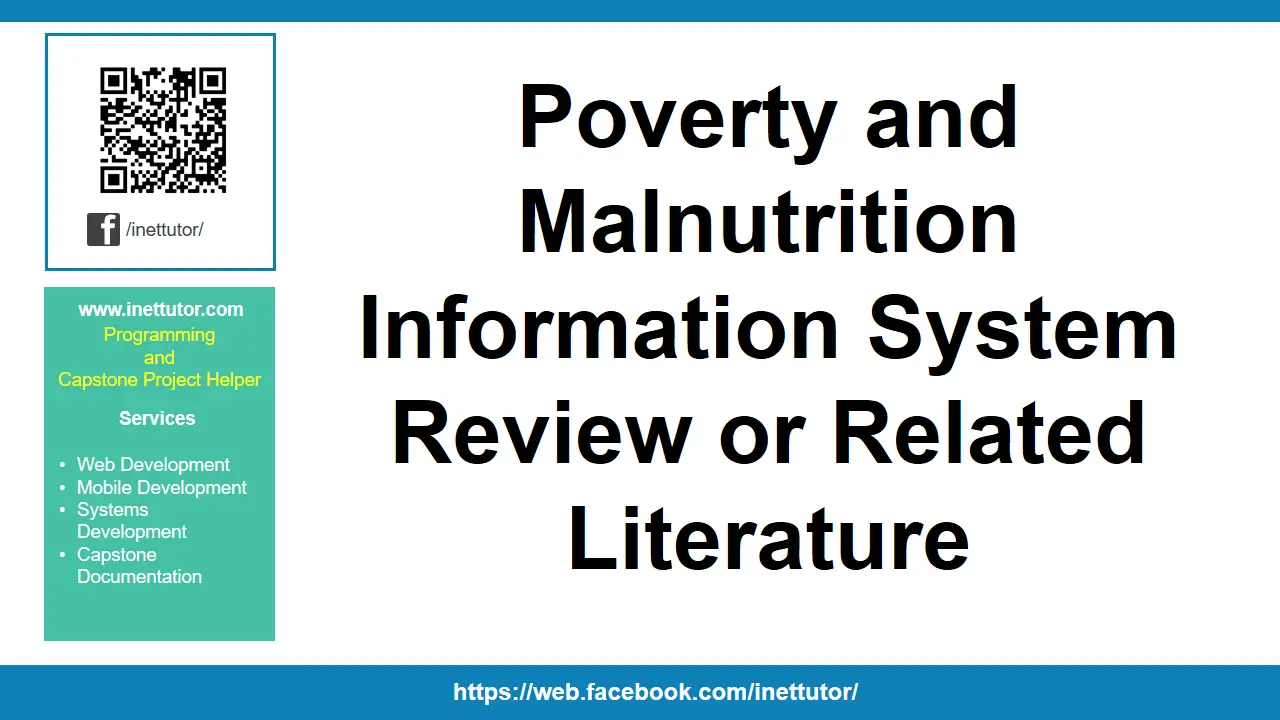Poverty and Malnutrition Information System Review or Related Literature
REVIEW OF RELATED LITERATURE, STUDIES, AND PRIOR ARTS SEARCH
This chapter presents related studies and literature from locally made and foreign studies.
RELATED LITERATURE
The Development of Web-Based management information system for the child malnutrition surveillance
According to Mera kartika delimayanti, Sigit Mulyono, Fajar Tri Waluyanti (December 2015) This research proposes an alternative early detecting system of child malnutrition within a number of regions in which CHCs are located based on the development of web-based system for the child malnutrition surveillance and integrated into an Internet network to facilitate its usage by medical personnel. The system is mainly aimed to ease CHC officials to input such systematic patient data that it is relatively fast to identify if there is a possible indication of child malnutrition within a particular area. The system is expected to be an early warning detector of children malnutrition cases and assist the head of health authority as a decision maker to take initiatives accordingly. Recommendations from the system are made available for users following which, health authority and the public can monitor the operation of the system directly by accessing the output data from the nutritional status study of a certain area (researchgate.net).

A concept of Urban Poverty Area Identification Using Spatial Correlation Studies on High resolution Satellite Imagery
According to Kuala Lumpur (June 21, 2014), the correlation and regression that have been applied will be used to determine the relationship of the study between the map and the socioeconomic problem. In this paper, a study has been made with an attempt to investigate and identified the urban poverty area by using visual interpretation method and spatial correlation study on high resolution IKONOS satellite imagery. The characteristics of urban poor which categorized in poverty will be accessed based on squatter and housing types visualized from acquired satellite images (fig.net).
Factors Influencing Malnutrition among Children Under 5 Years of Age in Kweneng West District of Botswana
According to Yankinda Etienne Kadima(November 2012), The purpose of this study was to identify and determine the risk factors for malnutrition among children under the age of Five (5) years in Kweneng West District of Botswana. A case control study was conducted. The cases consisted of 37 underweight children under the age of Five (5) (n=37), and the controls consisted of 76 children less than 5 years of age (n=76) recruited concurrently among the under-five children attending Letlhakeng Child Welfare Clinic on a monthly basis. The controls were of good nutritional status. Data collection was done using a combination of a review of records (child welfare clinic registers, and child welfare clinic cards) and structured questionnaires. Following placement of the data in regression models, the factors that were found to be significantly associated with child malnutrition were small number of daily meals taken by the child (Adjusted OR=19.04, 95% CI 3.24-112.13), lack of knowledge of methods of prevention of child malnutrition by the parent (Adjusted OR=4.71, 95% CI 1.41-15.82), parent’s unemployment (Adjusted OR=50.3, 95% CI 4.86-52.1), low birth weight (Adjusted OR=12.34, 95% CI 2.76-55.02), inadequate Vitamin A supplementation (Adjusted OR=13.27, 95% CI 1.94-90.46), child illness (OR=20.95, 95% CI 7.55-58.10), and child raised by a guardian (Adjusted OR=5.67, 95% CI 1.30-24.73). The findings from this study suggest that Socio-economic factors such as unemployment, a lack of knowledge about recommended infant and child feeding practices, the child raised by a guardian, and health-related factors such as low birth weight, inadequate Vitamin A supplementation, and child illness are predictors of malnutrition in under five. Therefore, increasing household food security and reinforcing educational interventions could contribute to a reduction in the prevalence of child malnutrition in the district (uir.unisa.ac.za).
Hierarchical human capability-based poverty targeting: An input to local development planning in the Philippines
According to Dina Magnaye (January 2015), It can be used in the preparation of local development plans by the local government units (LGUs) from the province to the municipality and city levels. The core poverty indicators of the Community-Based Monitoring System (CBMS) served as bases in establishing the human capability-based dimension of poverty. The poverty targeting methodology offers a strategic and poverty-focused approach in formulating local development plans that are responsive to the needs of local communities. It also serves as a tool to measure the achievement of the country’s global commitment to meeting its Millennium Development Goals (MDGs) targets and reducing poverty at the local level (researchgate.net).
Dietary Diversity of Pantawid Pamilyang Pilipino Program Beneficiary and Non-beneficiary Households in Selected Barangays in San Pablo City, Laguna, Philippines
According to Kristine Vigilla-Montecillo, Wilma A. Hurtada, Normahitta P. Gordoncillo, Dinah Pura t. depositario (2015), to analyze the household dietary diversity of beneficiary and non-beneficiary households of Pantawid Pamilyang Pilipino Program (4Ps) in selected barangays in San Pablo City, Laguna, Philippines and determine the nutritional status of children (6-60 months old) within these households. Methods. Household dietary diversity score (HDDS) was used as an indicator for the households’ dietary diversity. The nutritional status of children was determined using anthropometric data from the Barangay Health Centers. A total of 270 households was randomly selected through stratified random sampling with equal allocation. Results. Findings showed that beneficiary households had higher HDDS compared to the non-beneficiary households. The results also suggest that beneficiary households with larger household size, higher income, who were living in rural areas and who have female as well as more educated financial managers, tend to have a more diverse diet. On the other hand, a higher prevalence of malnutrition was observed among children in beneficiary households. Conclusion. Beneficiary households of 4Ps had better diet quality in terms of diversity than non-beneficiary households. However, the advantage of having a more diverse diet has not fully addressed the malnutrition problem among children as it was still widely prevalent in beneficiary households (asean-cites.org).
RELATED STUDIES
Cross-Sectional Study of Malnutrition and Associated Factors among School Aged Children in Rural and Urban Settings of Fogera and libo kemkem Districts, Ethiopia
According to the Ethiopian National Demographic Health Survey (2011), in this cross-sectional study, anthropometrics and individual and household characteristics data were collected from 886 children. Height for age z-score for stunting and body mass index for age z-score for thinness were computed. The prevalence of both wasting and stunting in children under 5 years is very high (10% and 44% respectively), while the situation in older children is not so well known. Furthermore, rural-urban disparities in child nutrition, as well as growing urbanization that results in increasing inequalities in urban areas, underlines the need to improve our knowledge of the main drivers of urban-rural differences (ncbi.nlm.nih.gov).
Child Poverty in the Philippines
According to Dr. Celia Reyes et al., (2015) in society es where poverty is a day-to-day struggle, children suffer the most as they comprise the most vulnerable group in any population. Poverty impacts directly on children’s physical and intellectual growth. In the Philippines, despite the country’s recent economic progress, poverty continues to affect millions of families, most of which have young children. The problem goes beyond mere lack of income or assets for these children’s families. Their situation speaks of a roster of factors that range from lack of appropriate skills to family heads’ inability to control ferƟ lity, intertwined with lack of job opportuniƟ es and other economic problems (www.unicef.org).
Community-Based Decision Support System for the Manila Health department
According to World Health Organization (WHO) (March 2014), Malnutrition is the gravest single threat to global public health. “Malnutrition essentially means “bad nourishment”, it concerns not enough as well as too much food, the wrong types of food, and the body’s response to a wide range of infections that result in improper absorption of nutrients or the inability to use nutrients properly to maintain health (.dlsu.edu.ph).
In Philippines, malnutrition continues to impact children’s lives
According to the Food and Nutrition Research Institute (2016) The Philippines Department of Education warns that as many as 1.8 million Filipino children suffer from “severe malnourishment”. And in a country where one in 10 Filipino family lives in extreme poverty, these findings come as no surprise. A recent survey conducted by the charity Save the Children found that one in four Filipino children sometimes skip meals and as many as 1.5 million children often go a whole day without a single meal. Children from the ages of 0-10 years old are the most at risk. This has potentially devastating short and long-term effects like stunting. If the trend continues in the coming years, then it will have a great impact on employment rates in the country and the economy will suffer (channelnewsasia.com).
1 in 3 Filipino kids still malnourished, stunted – study
According to Patty Pasion (2016), Manila, Philippines – Poor nutrition remains a major problem in the Philippines with 3.4 million children found to be stunted and over 300,000 underweight – all under 5 years old. A study released by the Inter-Agency Regional Analyst Network (RAN) and the Action Against Hunger (ACF) said these figures are alarming, given the growing economy of the Philippines. But the Philippines, the 9th among the countries with the highest prevalence of stunted kids, has had slow progress in addressing the issue. From a prevalence rate of 38% in 1998, the decrease has not been consistent, only reaching 30% in 2013 based on the estimates of United Nations (UN) agencies. Based on Food Nutrition and Research Institute (FNRI) data as of 2015, stunting or the chronic malnutrition rate among children is now at 33.4% (rappler.com).
PRIOR ART
Poverty Assessment in Degraded Rural Drylands in the Monte Desert, Argentina. An Evaluation Using GIS and Multi-criteria Decision Analysis
According to Cecilia Rubio, Elena María Abraham, Clara Rubio (March 2017),The work aims to contribute to the construction a local-scale poverty indicator, which contemplates multiple dimensions and allows for specialization of socioeconomic data for a rural area in the Monte Desert. Given the evident and widely studied relationship between desertification processes and poverty, and aiming to contribute to integrating socioeconomic information to desertification assessment and monitoring, there arises the need for spatializing poverty by addressing its multiple dimensions, aspects poorly developed thus far. For this purpose, a data model was designed, which enabled integrating quantitative and qualitative information within the scope of geographic ınformation systems (GIS) with multi-criteria decision analysis (MCDA), whereby it was possible to spatialize in detail the degree of poverty in the study area, laying the foundations for up-scaling the assessment to different scales. This work demonstrates the usefulness of GIS and MCDA as an instrument that enables progressing in new integral, interdisciplinary, multi-scale and multi-temporal approaches (link.springer.com)
Synthesis
The above stated literatures and studies serves as the guide in the development of Poverty and Malnutrition Information System. With the information presented on the gathered studies, the researchers can now identify the key features that will be included in the database system. In general, information is very important in creating decisions. The proposed system can organize records through the database technology that will help key personnel in addressing the problem in poverty and malnutrition.
Credit to the authors of the project
Our team can modify the project based on your specific business requirements.
You may visit our facebook page for more information, inquiries and comments.
Hire our team to do the project.


